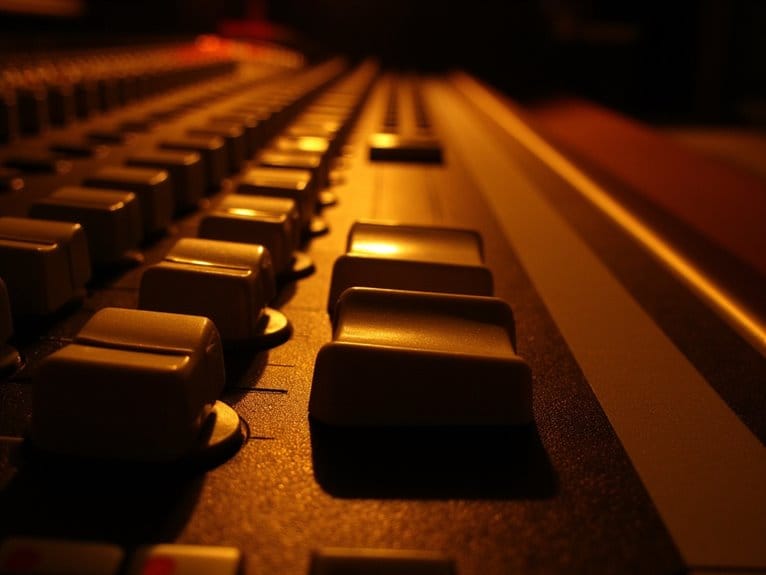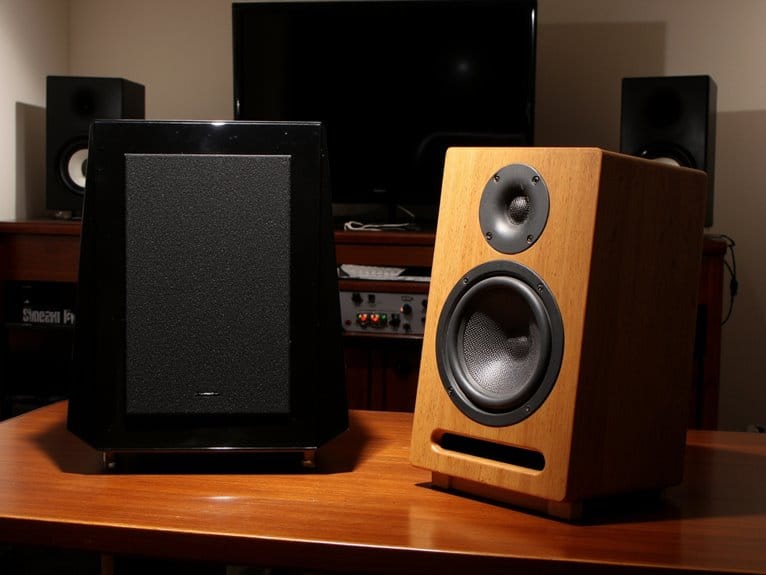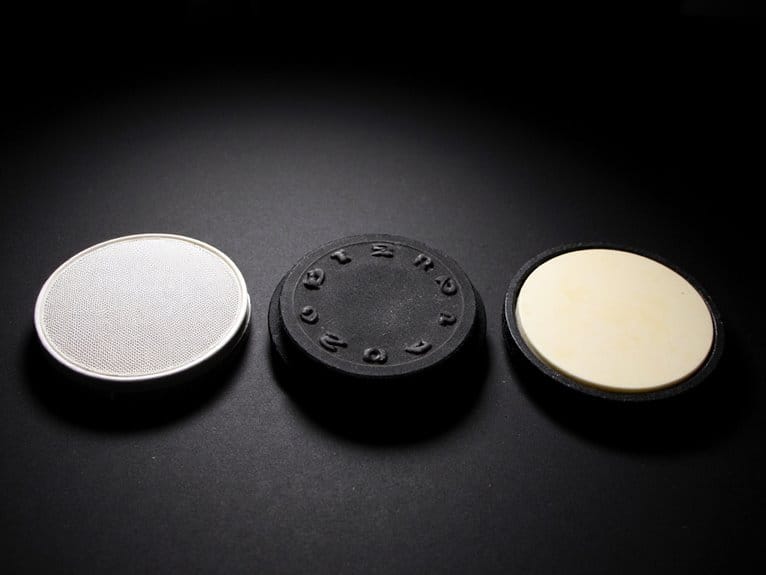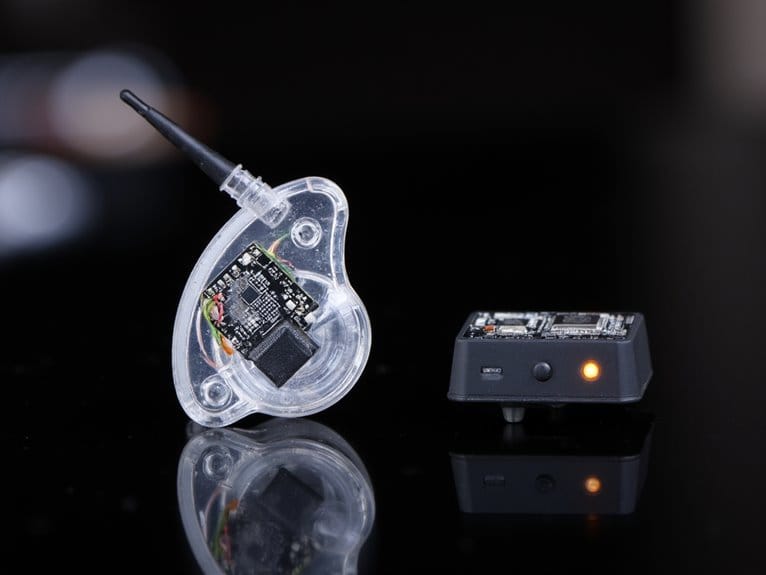Aesthetic Approach to Mixing: The Art of Audio Balance
You’ll achieve professional-sounding mixes by mastering four core aesthetic principles: establishing a solid volume foundation with your kick drum at -6 dB, sculpting frequency separation through strategic EQ cuts in three distinct zones, maintaining dynamic range that preserves both quiet details and powerful transients, and creating dimensional depth using reverb and delay on auxiliary channels. This systematic approach transforms flat recordings into immersive sonic environments where every element serves your artistic vision, and there’s much more to discover about each technique.
We are supported by our audience. When you purchase through links on our site, we may earn an affiliate commission, at no extra cost for you. Learn more.
Notable Insights
- Start mixing with all faders down, establish kick drum at -6dB as reference, then systematically layer elements.
- Master three frequency zones through strategic EQ cuts using narrow Q settings to eliminate masking and enhance clarity.
- Preserve dynamic range by balancing quiet details with powerful transients, avoiding over-compression that causes listener fatigue.
- Create dimensional depth using reverb to position sounds spatially and delay for subtle doubling or distinct echoes.
- Route time-based effects to auxiliary channels for independent control while maintaining frequency separation throughout the mix.
Crafting the Perfect Volume Foundation
While many producers instinctively reach for EQ and compression first, I’ve learned that establishing a solid volume foundation is the most critical step in creating a professional mix, and it’s surprisingly where most amateur recordings fall apart.
You’ll want to start with all faders down, then gradually introduce elements beginning with your kick drum around -6 dB, which creates a stable reference point for everything else.
These volume layering techniques require patience, as you’re building relationships between instruments rather than just making them loud.
Essential fader adjustments come next, where you’ll add bass, snare, and other core elements systematically, ensuring each new layer complements rather than competes with your existing foundation for ideal clarity.
Sculpting Sonic Space Through Frequency Control
Three distinct frequency zones exist in every mix – the low end that provides weight and foundation, the midrange where most musical content lives, and the high frequencies that add sparkle and air – and mastering EQ control within these zones transforms amateur recordings into polished, professional productions.
Mastering the three fundamental frequency zones-low end, midrange, and highs-separates amateur mixes from professional-grade productions.
You’ll achieve sonic clarity by strategically cutting problematic frequencies that create frequency masking between competing instruments.
I’ve found that narrow Q settings work best for subtractive EQ, precisely targeting muddy low-mids without affecting adjacent frequencies. When boosting for character enhancement, wider Q settings preserve natural audio textures while avoiding harsh peaks.
EQ precision comes from understanding that small cuts often create the psychoacoustic effect of boosting surrounding frequencies, effectively opening space without actually adding gain.
Use parametric EQs with frequency analyzers to identify buildup areas, then apply incremental adjustments that maintain each instrument’s fundamental character while ensuring every element occupies its distinct sonic territory. Capture your audio at 24-bit/192kHz resolution to preserve maximum detail and headroom during the EQ sculpting process.
Professional mixing requires high-quality audio interfaces that provide the transparent signal path and accurate monitoring necessary to make precise frequency decisions during the EQ process.
Mastering Dynamic Range and Energy Flow
Once you’ve carved out frequency territories for each instrument, dynamic range becomes the invisible force that breathes life into your mix, determining whether listeners lean forward with anticipation or tune out from compression fatigue.
I’ve learned that preserving dynamic nuances requires strategic compression with careful threshold and ratio settings, allowing quiet details to coexist with powerful transients without sacrificing overall energy.
Transient preservation becomes critical here-you’ll want to maintain attack characteristics that give drums their punch while controlling sustained elements through gentle limiting.
Modern digital formats offer 96 dB of headroom, yet many engineers still squash mixes into lifeless walls of sound. Your goal isn’t maximum loudness but finding that sweet spot where perceived volume meets emotional impact, creating energy arcs that sustain listener engagement throughout the entire track.
Creating Dimensional Depth With Time-Based Effects
Beyond the solid foundation of frequency separation and dynamic control, time-based effects transform your two-dimensional mix into a three-dimensional soundscape where instruments float at different depths, creating the illusion that listeners can walk around inside your music.
Reverb techniques like hall and room variations push sounds backward or forward, while delay types ranging from subtle doubling to distinct echoes establish spatial cues that define perceived distance.
Chorus effects thicken elements without obvious repetition, and pitch shifting through granular synthesis creates complex textures that expand your sonic palette.
Your mixing strategies should route these effects to auxiliary channels, allowing independent EQ and compression control while maintaining clarity.
These depth perception tools transform flat recordings into immersive environments.
On a final note
You’ve now got the essential tools to transform your mixes from amateur to professional. Remember, great mixing isn’t about following rigid rules-it’s about developing your ear and trusting your instincts. Start with solid volume relationships, carve out frequency space for each element, control your dynamics thoughtfully, and add spatial depth strategically. Practice these fundamentals consistently, and you’ll develop the aesthetic sensibility that separates good mixers from great ones.







